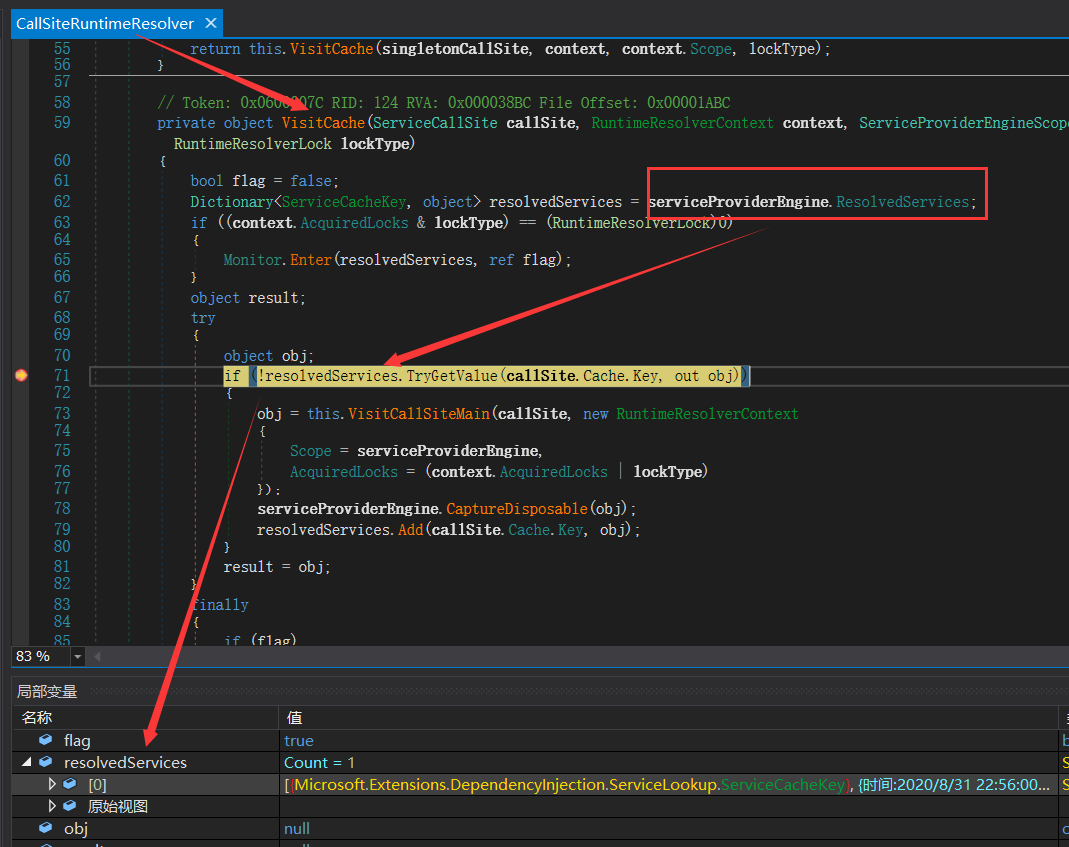終於弄明白了 Singleton,Transient,Scoped 的作用域是如何實現的
阿新 • • 發佈:2020-09-01
## 一:背景
### 1. 講故事
前幾天有位朋友讓我有時間分析一下 aspnetcore 中為什麼向 ServiceCollection 中注入的 Class 可以做到 Singleton,Transient,Scoped,挺有意思,這篇就來聊一聊這一話題,自從 core 中有了 ServiceCollection, 再加上流行的 DDD 模式,相信很多朋友的專案中很少能看到 new 了,好歹 spring 十幾年前就是這麼幹的。
## 二:Singleton,Transient,Scoped 基本用法
分析原始碼之前,我覺得有必要先介紹一下它們的玩法,為方便演示,我這裡就新建一個 webapi 專案,定義一個 interface 和 concrete ,程式碼如下:
``` C#
public class OrderService : IOrderService
{
private string guid;
public OrderService()
{
guid = $"時間:{DateTime.Now}, guid={ Guid.NewGuid()}";
}
public override string ToString()
{
return guid;
}
}
public interface IOrderService
{
}
```
### 1. AddSingleton
正如名字所示它可以在你的程序中保持著一個例項,也就是說僅有一次例項化,不信的話程式碼演示一下哈。
``` C#
public class Startup
{
public void ConfigureServices(IServiceCollection services)
{
services.AddControllers();
services.AddSingleton();
}
}
[ApiController]
[Route("[controller]")]
public class WeatherForecastController : ControllerBase
{
IOrderService orderService1;
IOrderService orderService2;
public WeatherForecastController(IOrderService orderService1, IOrderService orderService2)
{
this.orderService1 = orderService1;
this.orderService2 = orderService2;
}
[HttpGet]
public string Get()
{
Debug.WriteLine($"{this.orderService1}\r\n{this.orderService2} \r\n ------");
return "helloworld";
}
}
```
接著執行起來多次重新整理頁面,如下圖:

可以看到,不管你怎麼重新整理頁面,guid都是一樣,說明確實是單例的。
### 2. AddScoped
正從名字所述:Scope 就是一個作用域,那在 webapi 或者 mvc 中作用域是多大呢? 對的,就是一個請求,當然請求會穿透 Presentation, Application, Repository 等等各層,在穿層的過程中肯定會有同一個類的多次注入,那這些多次注入在這個作用域下維持的就是單例,如下程式碼所示:
``` C#
public void ConfigureServices(IServiceCollection services)
{
services.AddControllers();
services.AddScoped();
}
```
執行起來多次重新整理頁面,如下圖:

很明顯的看到,每次刷 UI 的時候,guid都會變,而在同一個請求 (scope) 中 guid 是一樣的。
### 3. AddTransient
前面大家也看到了,要麼作用域是整個程序,要麼作用域是一個請求,而這裡的 Transient 就沒有作用域概念了,注入一次 例項化一次,不信的話上程式碼給你看唄。
``` C#
public void ConfigureServices(IServiceCollection services)
{
services.AddControllers();
services.AddTransient();
}
```

從圖中可以看到,注入一次就 new 一次,非常簡單吧,當然了,各有各的應用場景。
之前不清楚的朋友到現在應該也明白了這三種作用域,接下來繼續思考的一個問題就是,這種作用域是如何做到的呢? 要想回答這個問題,只能研究原始碼了。
## 三:原始碼分析
aspnetcore 中的 IOC 容器是 ServiceCollection,你可以向 IOC 中注入不同作用域的類,最後生成 provider,如下程式碼所示:
``` C#
var services = new ServiceCollection();
services.AddSingleton();
var provider = services.BuildServiceProvider();
```
### 1. AddSingleton 的作用域是如何實現的
通常說到單例,大家第一反應就是 static,但是一般 ServiceCollection 中會有成百上千個 AddSingleton 型別,都是靜態變數是不可能的,既然不是 static,那就應該有一個快取字典什麼的,其實還真的有這麼一個。
#### 1)RealizedServices 字典
每一個 provider 內部都會有一個 叫做 RealizedServices 的字典,這個 字典 將會在後面充當快取存在, 如下圖:

從上圖中可以看到,初始化的時候這個字典什麼都沒有,接下來執行 `var orderService = provider.GetService();` 效果如下圖:

可以看到 RealizedServices 中已經有了一個 service 記錄了,接著往下執行 `var orderService2 = provider.GetService();`,最終會進入到 `CallSiteRuntimeResolver.VisitCache` 方法判斷例項是否存在,如下圖:

仔細看上面程式碼的這句話: `if (!resolvedServices.TryGetValue(callSite.Cache.Key, out obj))` 一旦字典存在就直接返回,否則就要執行 new 鏈路,也就是 ` this.VisitCallSiteMain`。
綜合來看,這就是為什麼可以單例的原因,如果不明白可以拿 dnspy 仔細琢磨琢磨。。。
### 2. AddTransient 原始碼探究
前面大家也看到了,provider 裡面會有一個 DynamicServiceProviderEngine 引擎類,引擎類中用 字典快取 來解決單例問題,可想而知,AddTransient 內部肯定是沒有字典邏輯的,到底是不是呢? 除錯一下唄。

和單例一樣,最終解析都是由 CallSiteRuntimeResolver 負責的,AddTransient 內部會走到 VisitDisposeCache 方法,而這裡會一直走 `this.VisitCallSiteMain(transientCallSite, context)` 來進行 例項的 new 操作,還記得單例是怎麼做的嗎? 它會在這個 VisitCallSiteMain 上包一層 resolvedServices 判斷,
